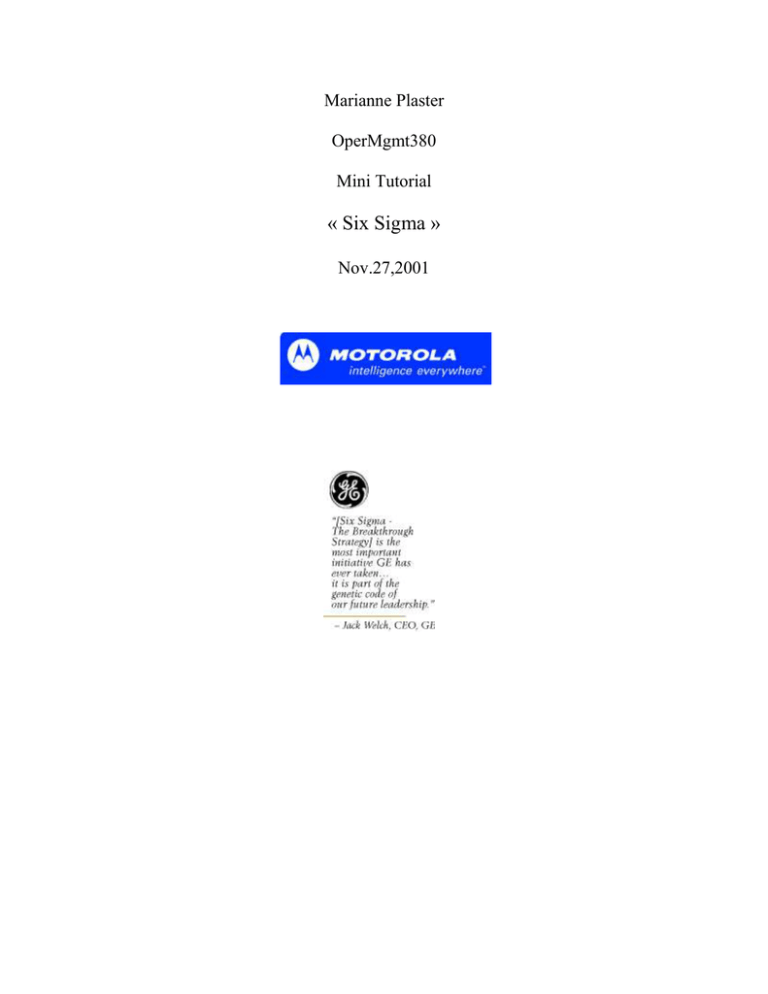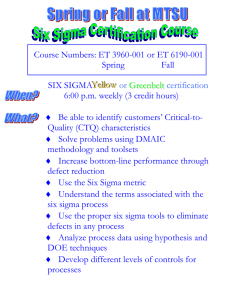
Marianne Plaster
OperMgmt380
Mini Tutorial
« Six Sigma »
Nov.27,2001
Introduction:
Six Sigma was the expression given as a synonym by Motorola in 1986 for their
quality program. Since then, a general defenition has developed, and it has become a
useful technique for measuring quality. It has become a tool used particularly among
technology driven companies such as Allied Signal, General Electric, Kodak, and Texas
Instruments. What does it mean to be “Six Sigma” anyway? Its goal is to reduce output
varibability through process improvement. Six Sigma refers to an organizations measure
of quality that strives for near perfection. What can it do for your organization? If your
organization is focused on customer satisfaction, then Six Sigma will offer you a method
and some tools for identification and improvement of both internal and external process
problems to better meet customers’ needs by identifying the variations in your
organization’s processes that might influence the customer’s point of view negatively.
How Does Six Sigma Work, and How To:
How to:
Okay, okay, how do you use Six Sigma then? Six Sigma is based on the normal
distribution theorem by Carl-Friedrich Gauss with this formula:
This formula describes a curve whose form is defined by two parameters, the mean
average value, and the standard deviation “sigma.” Six Sigma is the tool used to help
design highly capable parts that meet set specifications, namley customer specifications.
These specifications are +/- six standard deviations from the process mean, which is the
center line.
2
As you can see from the picture, +/-6 deviations (6 sigma) contains 99.9999% of
all values. It can never reach 100% though. This means that there will always be room
for improvement. Requirements and environmental boundaries must be considered when
calculating a six sigma value as well.
The idea is to identify all of the opportunities for defects and then count the actual
number of them that occur, and then normalize this value to one million opportunities to
find the Defects per Million Opportunities. Now you can determine the corresponding
sigma value. You must locate a table of values for the one-sided normal distribution.
3
http://www.sixsigma.de/english/sixsigma/6s_e_values.htm is a fairly simple one to
follow. Ideally, defects should be below 3.4 defects (standard deviations) per million
opportunities for a defect. This means that ideally, the implementation of six sigma will
result in an average of only about 3.4 defects per million units produced.
Other Helpful Sources for Six Sigma Information:
1.)
General Electric created a Six Sigma Academy in 1994. This is the Web Site
address. It may be helpful for more information and training.
http://www.6-sigma.com/
2.)
iSixSigma, Six Sigma Quality Resources for Achieving Six Sigma Results. This
web site has plenty of information, discussion forums, and updated news on the subject,
and job shops as well.
http://www.isixsigma.com/
3.)
This site is also a good source of information and offers defenitions and step by
step instruction on the how to’s of Six Sigma.
http://www.sixsigma.de/
4.)
General Electric is considered one of the Benchmarks in this area. This web site
is very helpful, not only for information, but for some real life uses.
http://www.ge.com/sixsigma/
5.)
Motorola is the company who introduced this method. It is also considered a
major benchmark for Six Sigma Method.
http://www.qa-inc.com/knowledgecente/articles/SixSig_pg1-3.html
4
Conclusion:
Six Sigma is far more in depth than this document has illustrated. It is a tool that
if used correctly, can identify key areas of business processes that need attention to lower
defect rates. One of the greatest advantages is that all the measured improvements
achieved through this techneque can be directly converted into financial results. In fact,
more and more shareholders even require that Six Sigma method be implemented.
5
References:
Web Sites:
1.) http://www.sixsigma.de/english/index.htm
Copyright © 2000 SIX SIGMA IT-Concepts
Release date: Oktober 06, 2000
(Pictures borrowed from this site)
2.) http://www.sixsigma.de/english/sixsigma/6s_e_theory.htm
Copyright © 2000 SIX SIGMA IT-Concepts
Release date: September 30, 2000
3.) http://www.isixsigma.com
©2000-2001 iSixSigma LLC. All rights reserved
4.) http://www.sixsigma.de/
Copyright © 2001 SIX SIGMA EDV-Konzepte Kurt Haubner
Stand: 14. November 2001
5.) http://www.schneiderman.com/The_Art_of_PM/six_sigma_metric/six_sigma_metric.htm
©1999-2001, Arthur M. Schneiderman All Rights Reserved
Last modified: September 23, 2000
6.) http://www.motorola.com/cgiss/markets.shtml
© Copyright 1994-2001 Motorola, Inc. All Rights Reserved
(Borrowed Motorola logo image from here)
7.) http://www.ge.com/sixsigma/
© General Electric Company 1997-2001
(Borrowed GE Logo image here)
Books:
7.) Managing Quality: An Integrative Approach. Foster, Thomas S. Copyright
2001. Prentice-Hall, Inc. New Jersey.
6




